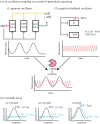Bacterial degrons in synthetic circuits
- PMID: 35975648
- PMCID: PMC9382460
- DOI: 10.1098/rsob.220180
Bacterial degrons in synthetic circuits
Abstract
Bacterial proteases are a promising post-translational regulation strategy in synthetic circuits because they recognize specific amino acid degradation tags (degrons) that can be fine-tuned to modulate the degradation levels of tagged proteins. For this reason, recent efforts have been made in the search for new degrons. Here we review the up-to-date applications of degradation tags for circuit engineering in bacteria. In particular, we pay special attention to the effects of degradation bottlenecks in synthetic oscillators and introduce mathematical approaches to study queueing that enable the quantitative modelling of proteolytic queues.
Keywords: degradation; oscillatory circuits; proteases; queueing theory.
Conflict of interest statement
We declare we have no competing interests.
Figures








Similar articles
-
Toxin-based screening of C-terminal tags in Escherichia coli reveals the exceptional potency of ssrA-like degrons.bioRxiv [Preprint]. 2024 Apr 12:2024.01.29.576913. doi: 10.1101/2024.01.29.576913. bioRxiv. 2024. PMID: 38352471 Free PMC article. Preprint.
-
Post-translational control of genetic circuits using Potyvirus proteases.Nucleic Acids Res. 2016 Jul 27;44(13):6493-502. doi: 10.1093/nar/gkw537. Epub 2016 Jun 13. Nucleic Acids Res. 2016. PMID: 27298256 Free PMC article.
-
[Proteolysis in bacteria--a review].Wei Sheng Wu Xue Bao. 2015 May 4;55(5):521-8. Wei Sheng Wu Xue Bao. 2015. PMID: 26259475 Review. Chinese.
-
Entrainment of a Bacterial Synthetic Gene Oscillator through Proteolytic Queueing.ACS Synth Biol. 2017 Mar 17;6(3):455-462. doi: 10.1021/acssynbio.6b00157. Epub 2016 Dec 21. ACS Synth Biol. 2017. PMID: 27935286
-
Applications of Bacterial Degrons and Degraders - Toward Targeted Protein Degradation in Bacteria.Front Mol Biosci. 2021 May 7;8:669762. doi: 10.3389/fmolb.2021.669762. eCollection 2021. Front Mol Biosci. 2021. PMID: 34026843 Free PMC article. Review.
Cited by
-
Toxin-based screening of C-terminal tags in Escherichia coli reveals the exceptional potency of ssrA-like degrons.bioRxiv [Preprint]. 2024 Apr 12:2024.01.29.576913. doi: 10.1101/2024.01.29.576913. bioRxiv. 2024. PMID: 38352471 Free PMC article. Preprint.
-
Proteolytic stability and aggregation in a key metabolic enzyme of bacteria.Proc Natl Acad Sci U S A. 2024 May 7;121(19):e2301458121. doi: 10.1073/pnas.2301458121. Epub 2024 Apr 29. Proc Natl Acad Sci U S A. 2024. PMID: 38683989 Free PMC article.
-
Predictive genetic circuit design for phenotype reprogramming in plants.Nat Commun. 2025 Jan 16;16(1):715. doi: 10.1038/s41467-025-56042-2. Nat Commun. 2025. PMID: 39820378 Free PMC article.
-
Editing Streptomyces genome using target AID system fused with UGI-degradation tag.Eng Life Sci. 2024 Jun 24;24(8):e2400005. doi: 10.1002/elsc.202400005. eCollection 2024 Aug. Eng Life Sci. 2024. PMID: 39113812 Free PMC article.
-
Engineering a New SsrA-Based Degradation Tag (LAA-LAA) and a Bacterial Synthetic Oscillator.ACS Synth Biol. 2025 Apr 18;14(4):1062-1071. doi: 10.1021/acssynbio.4c00612. Epub 2025 Mar 19. ACS Synth Biol. 2025. PMID: 40106229
References
Publication types
MeSH terms
Substances
Grants and funding
LinkOut - more resources
Full Text Sources

